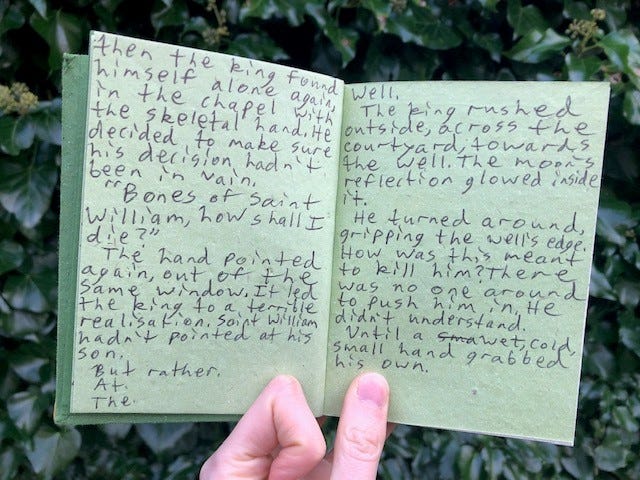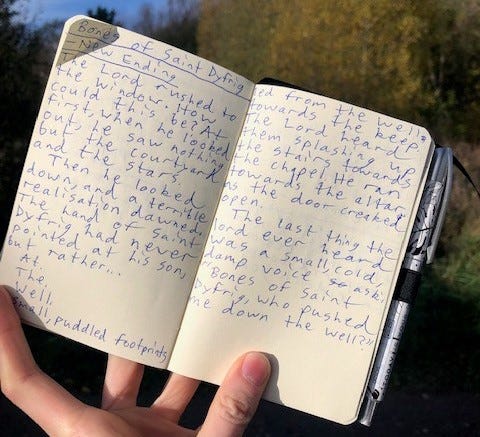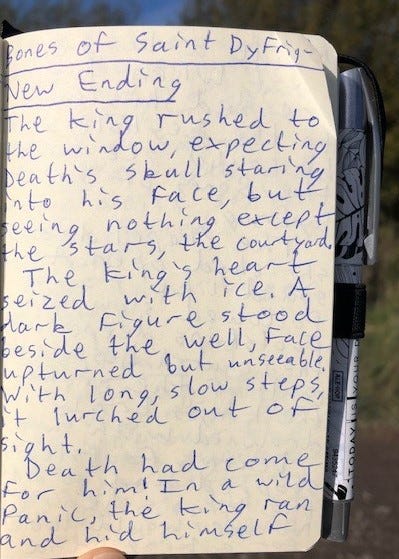The Five Endings of "Bones of Saint Dyfrig, How Shall I Die?"
Six hundred-words, five attempts
As you can imagine, I’ll be spoiling the ending of my short story “Bones of Saint Dyfrig, How Shall I Die?”. If you’d like to read the story before this blog post, head over to Gwyllion Magazine to buy a copy.
On the surface, a folktale seems simple to write. They have a certain structure, a certain style. Characters are archetypes, often without their own names. Instead, the focus is on the almost ritualistic nature of the events unfolding.
When I wrote Bones of Saint Dyfrig, How Shall I Die? however, I realised how difficult writing a new folktale can be. What frustrated me the most was coming up with a satisfying ending.
So much so it took me five tries.
First Ending – But Would He Really, Though?

I wrote the first draft of Bones of Saint Dyfrig after telling the story to myself in the shower. At the time it seemed like a tale fully formed. Indeed, the first half hasn’t changed much since the first time I rushed it down onto paper.
The withered hand of a long-dead saint points at the answers to questions asked of it. A king decides to ask how he will die. The hand points at his son, playing by the castle’s well. Fearful of losing his crown, the king pushes his son down said well. After a year of guilt, the king decides to ask the Bones his question again. To his horror, the hand points outside – towards the very well he pushed his son into.
Here’s a transcription of the first ending:
The king rushed outside, across the courtyard, towards the well. The moon’s reflection glowed inside it.
He turned around, gripping the well’s edge. How was this meant to kill him? There was no one around to push him in. He didn’t understand.
Until a wet, cold, small hand grabbed his own.
Ignore the terrible writing for a moment. Ignore how it doesn’t fit in with the folktale tone. Ignore the lack of tension or build-up to the king’s just demise. Why would someone willingly rush out to the place where they’re meant to die? Even in the dream-like logic of the folktale it didn’t make much sense. Ending scrapped.
Second Ending – Zooming By
In the second draft, the danger is brought to the king instead of him foolishly rushing to meet it:
Small, puddled footprints led from the well towards the keep. The Lord [I was debating between ‘lord’ and ‘king’ at the time] heard them splashing up the stairs towards the chapel. He ran towards the altar as the door creaked open.
The last thing the lord ever heard was a small, cold, damp voice ask;
“Bones of Saint Dyfrig, who pushed me down the well?”
This ending solved my previous problem but created a few more. Not only was the ending rushed, reducing the tension and therefore the scares, but the ‘small…footprints’ made the twist too obvious.
Time to try again.
Third Ending – Getting Closer…
Although I wasn’t happy with the second version, it did give me an idea to ramp up the tension; having the King attempt to hide from his fate:
Pairs of glimmering puddles led away from the well out of sight. The King asked again, “Bones of Saint Dyfrig, how shall I die?”
It turned its finger towards the chapel doors.
The king ran to hide behind the altar, beneath the Bones of Saint Dyfrig. Despite the cold of the night, sweat drowned his brow.
The chapel door shrieked open. Each step inside was marked by a thousand drips. The King held his breath. The altar was wide and grand, fitting for a relic. He couldn’t be found.
He listened to the drips as they scattered closer up the aisle. After too long, they stopped on the other side of the altar.
Even the King’s heart slowed, lest it be heard. Just a moment more, he told it, then himself. A moment more and the creature will go.
A moment passed. Then another.
“Bones of Saint Dyfrig,” a small, cold, damp voice said. “Who pushed me down the well?”
I got to read this version out at a Halloween event and was strongly encouraged by the trauma I inflicted. Yet I still wasn’t satisfied. Why?
Because at the same time, I also received feedback from a failed submission attempt. They suggested that the story’s different elements – the prince, the well, - didn’t connect well enough to make the plot understandable. With this useful bit of feedback in mind, I went back to the drawing board.
Fourth Ending – Woe, Death Upon Ye!
The King’s heart seized with ice. A dark figure stood beside the well, face upturned but unseeable. With long, slow steps, it lurched out of sight.
Death had come for him! In a wild panic, the King ran and hid himself inside a large chest. When he pressed his eye to the keyhole, all he could see were the Bones of Saint Dyfrig.
The chapel doors shrieked open. A sound like rain followed slow, plodding footsteps deeper into the church. Despite the cold of the night, the King’s brow drowned with sweat.
Death’s footsteps stopped and so did the King’s heart. No one would look for a king in a chest. Not even Death could be so absurd.
“Bones of Saint Dyfrig,” a small, cold, damp voice said. “Who pushed me down the well?”
The hand began to move.
The King now has a convenient chest to hide inside. What I liked about the chest was the imagery of the king pressing his eye to the keyhole, without being able to see what has stalked into the chapel after him. It’s also more claustrophobic than hiding behind an altar. If you’ve ever tried hiding in your toy chest as a child, you’ll get the idea.
Instead of footprints, the King believes he sees Death itself, though the reality is far worse. A physical figure he can’t quite identify, but who looks threatening enough for the King to hide from.
In hindsight I could have used this ending. I think what put me off at the time was believing there was no reason for the King to assume the figure was after him, despite the Bones pointing towards it. There’s also more focus on the figure than the well, reducing the foreshadowing slightly.
These are all nitpicks, however. Which meant the perfect ending was just around the corner.
Final Ending – Thinking Further
The moment when your story comes together is never as dramatic as you think it will be.
There’s no swelling orchestra at your back as you run through the streets, towards home and your stationary on the one day you forgot to take notebook and pen out with you. It’s often a casual thought that pops up while you’re doing or thinking about something completely different.
To create a satisfying ending, I realised I needed to think further back in the story, even before the scene I’d dissected so many times. When it comes to an ending, what’s set-up before can be just as important as the last scene itself.
If you want to read that ending for yourself and see if you think it works, you can find it in Issue 7 of Gwyllion Magazine. Shameless self-promotion, I know. But after the five tries it took me to get there, I feel I’ve earnt the right.




Do we get to vote on our favourite ending??? My pick is No. 1